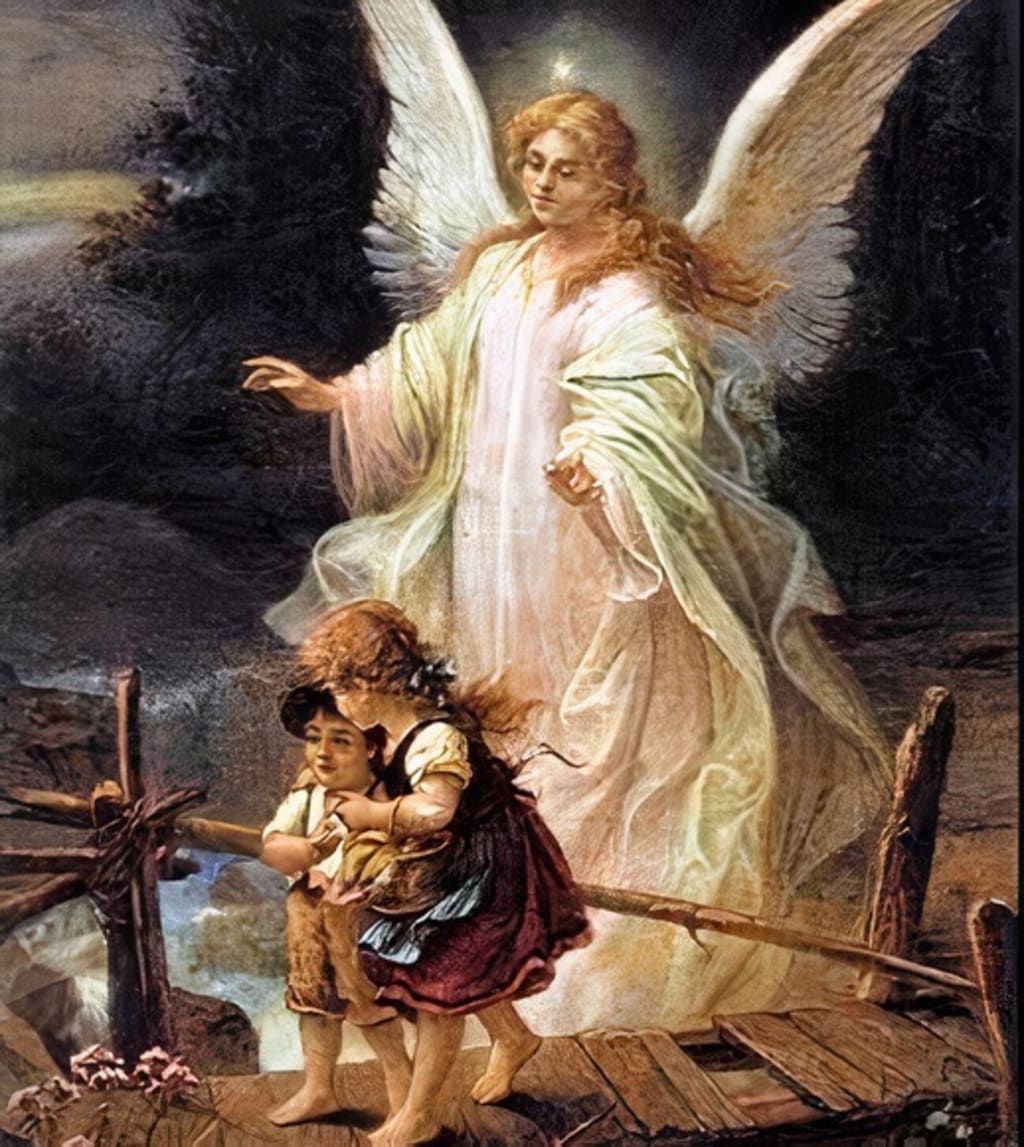Writing Ekphrastic Haiku in Liturgical Time
For Elizabeth Samuels

Dear Elizabeth,
On my usual walk to Greynolds Park, searching for something, as Bashō said, that would make “my mind leap,” I thought about your Facebook post on October 2, 2023: “Today is the Feast of the Holy Guardian Angels.”
Heathen that I am, I didn't know about many of the events on the Catholic Calendar. So when I came home, I researched “The Feast of the Holy Guardian Angels” at The National Catholic Register: “A Roman Catholic feast day honoring the guardian angels God appoints to protect and guide each person.” As I read the article, I realized that whereas I was living in ordinary time, you were living in the liturgical time of the Roman Catholic Church, rich with tradition and meaning and a storehouse of images for writing ekphrastic haiku in liturgical time.
This is not as farfetched as it sounds. Emerging from Shinto and Zen Buddhism's animist roots, haiku helped poets to reveal how they experienced a momentary glimpse of the seasons and nature's interconnectedness. Although he never became a Buddhist monk, Bashō wrote many haiku that incorporated Buddhist teachings*. Based on an image a friend had sent him, Bashō wrote this haiku:
Glory to Buddha,
On a pedestal of grass--
Such coolness.
Here is another of his famous haiku, 枯朶に 烏のとまりけり 秋の暮れ, translated from Japanese into English:
kare eda ni
karasu no tomarikeri
aki no kure
On a withered branch
A crow is perched
An autumn evening.
With only 17 syllables ("on" or "onji"), Bashō uses natural imagery to reflect the autumn-to-winter seasonal transition. Written in the present tense, a lone crow resting on a leafless branch in the evening establishes the melancholy atmosphere of late fall. Through seasonal references (kigo), Bashō creates a feeling of impermanence in the poem's structure, which influenced generations of haiku poets.
And, like everything else, haiku was not immune to change. By the early 20th century, when Western writers like Ezra Pound and R.H. Blyth introduced haiku to English speakers, the “rules” evolved to bridge Japanese and Western cultures. According to Clark Strand: “For a haiku to work in English, it must use the techniques of English language poetry, including metaphor and simile, rhyme, personification, allegory, and more. In practice, this means relaxing our notion of what a haiku ought to be. A haiku in English is “whatever you can get away with” in 17 syllables—with the added caveat that it include a season word.”
But whether you are writing haiku in Japanese or English, one of the fundamental questions of haiku becomes evident: How are you experiencing time?
Rather than seasonal references to persimmons and scarecrows, your haiku could feature details related to the Catholic holy days in autumn: All Saints Day, All Souls Day, and Advent. You have done the most challenging part already with your studies and, along the way, have gleaned certain insights. The next step is to personalize these insights. The movement of your haiku would resemble the Zen practice:
源氏 (samadhi) - concentration/focus
悟り (satori) - poetic realization/insight
私化 (shika) - personalization/relating to oneself
But how do you write what the Haiku Foundation calls “ekphrastic haiku”: a snapshot-like perspective on a work of visual art, using the core features of traditional haiku to reflect on and interpret the artwork within the confines of 17 syllables? And how do you write the haiku in liturgical time?
First, choose a painting that depicts an event from the Catholic calendar. Spend some time looking at the artwork, and ask yourself the following questions:
Who or what is the subject of the painting?
What idea does the painting suggest?
How do you relate to the mood?
How does the painting speak to you?
Describe the scene in the present tense and answer the questions a haiku answers:
What is happening, and who is involved?
When is this happening?
Where is this happening?
Now, use your imagination to enter the painting. Look around. What do you see, hear, smell, taste, and feel? Create a sensory pool so you can write a poem like Emily Dickinson advises: “Tell it slant."
To write my ekphrastic haiku, I used the painting that came with the article from the National Catholic Register, “Guardian Angel” by Fridolin Leiber.
On a broken bridge,
behind homeward-bound children
a flutter of wings.
The broken bridge sets the scene for the action--the awareness, some might say, of the world's apparent disjointedness. The second verse describes the innocence of children's actions and their intention of getting home safely. The third line, “a flutter of wings,” reveals the divine protection of an angel (“Tell it slant”) who has been with them (without the children’s conscious knowledge—that will come later) since the start of their journey. The movement of the haiku signifies a journey from brokenness to wholeness, and the painting has been the medium for that realization.
Of course, writing ekphrastic haiku doesn’t have to be limited to the liturgical calendar of the Roman Catholic Church. Our sisters and brothers from other faith traditions could write haiku based on the Jewish or Ethiopian calendars with their rich traditions of religious art, Or you could use the lectio divina method from your daily scripture readings. But that’s for another post. The possibilities are endless!
*See also A Zen Wave by Robert Aitken.
About the Creator
Geoffrey Philp
I am a Jamaican writer. I write poems (haiku & haibun), stories & essays about climate change, Marcus Garvey, music icons such as Bob Marley, and the craft of writing through personal reflection & societal engagement.
Reader insights
Outstanding
Excellent work. Looking forward to reading more!
Top insights
Compelling and original writing
Creative use of language & vocab
Expert insights and opinions
Arguments were carefully researched and presented
Eye opening
Niche topic & fresh perspectives
Heartfelt and relatable
The story invoked strong personal emotions
On-point and relevant
Writing reflected the title & theme







Comments (12)
Darkness sets its shroud, Hesitating childish steps, Divine vigil guards.
I learned so many new things from you today! This was so fascinating! Thank you so much for sharing this with us and congratulations on your Top Story!
Dear Geoffrey, great story! Thank you!
I really enjoyed the detailed explanations in this. Loved your haiku, too.
Nice work I loved it ❤️🤗 I hope my stories get to the top one day 😪💔
Brilliant, poetic and infinitely useful to other writers. I will be reading this several times.
Is this a piece you shared with E. S. And are sharing with us? It is a fine piece of "direction" in any case.
I had no idea, thank you for sharing.
Agree with Dani, this was incredibly enrapturing and full of education. I would love a class taught by you; your style here is thick with authority and knowledge, yet extremely fascinating. I applaud you! I learned so much, and feel inspired! I’ve actually been wanting to write more ekphrastic poetry and stories. So imagine my surprise when I saw your article on the homepage ( congrats btw)! Also, love your haiku! You told it slant and painted a whole scene and religious experience, with layers of perception. Just beautiful work.
Nice, Congratulations on your Top Story🎉😉✌️💯
I really appreciate and love the level of detail and passion you put into this piece. You inspired me!! I may write a piece based on this. I will definitely put your article as the key to my inspiration!!!
You went into detail I was not expecting and was wowed as a result. Familiar topic deconstructed and reconstructed with your own personal nuances for teaching purposes, and teach you did! So fluently! Consider an online course or workshop if you haven't already. You are to be commended.